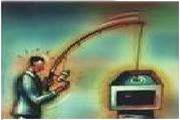
But the traditional precursor patterns are even more pronounced this year, according to Andrew Klein, director of email security at SonicWALL.
"Phishers are getting better at optimising the relevancy factor of their attacks by analysing human behaviour and interposing themselves credibly at the right moment to maximise the chances of successful fraud," said Klein.
"In the November to December gift-giving season, individuals who normally make only a few credit card purchases a month are suddenly doing multiple transactions.
"People use different financial instruments and it is not easy to remember everything they've bought, and how they paid for it. When people are uncertain they are vulnerable to trickery, which cyber-criminals are counting on."
Klein explained that scammers use November and December to gather the email addresses of potential victims for January.
While traditional spam increased slightly in the fourth quarter of 2007, the real increase is in directory harvest attacks used to discover email addresses.
These attacks nearly doubled from the third to the fourth quarter of 2007, according to SonicWALL statistics.

_(22).jpg&h=140&w=231&c=1&s=0)

.png&h=140&w=231&c=1&s=0)






 iTnews Executive Retreat - Security Leaders Edition
iTnews Executive Retreat - Security Leaders Edition











_(1).jpg&h=140&w=231&c=1&s=0)



